Top 10 Points of Differences Between a Traditional and VoIP Carrier
Everytime a new technology comes around, it replaces the older one. However, that isn’t always the case. Sometimes, the newer technology complements the older one.
While there are overlaps in terms of operations and capabilities, they’re not enough for the newer technology to replace the older one.
You can clearly observe this situation in the world of telecommunication. We have Voice over Internet Protocol (VoIP) and traditional carriers co-existing and providing communication facilities to everyone.
This raises two important questions, how are VoIP and traditional carriers different and how should you choose among the two?
In this blog post, we'll discuss the differences between a traditional carrier and a VoIP carrier, their advantages and disadvantages. Learning all of this should help you choose one that suits your requirements in the best way possible.
But before we dive into the details, let's start with the basics.
What is a Traditional Carrier or PSTN?

A traditional carrier refers to a telecommunications company that uses physical lines to transmit voice and data signals and provide communication service. These lines can be copper wires, fiber-optic cables, or satellite connections.
The services include voice calling, texting, and internet access. Traditional carriers are also called Public Switched Telephone Networks (PSTN) and have been around for over a century.
These companies have been in the industry for a long time and have established their networks to provide reliable services to their customers.
Examples of traditional telecom carriers include AT&T, Verizon, T-Mobile, and Sprint in the United States, and BT, Vodafone, and O2 in the United Kingdom.
These companies own their own physical networks and provide services to customers through contracts or pay-as-you-go plans. They typically charge for each service separately and may require long-term contracts or deposits for certain plans.
What is a VoIP Carrier?

A VoIP (Voice over Internet Protocol) telecom carrier is a type of telecommunications provider that offers voice and other multimedia communication services over the internet.
Unlike traditional telecom carriers that use analog or digital circuit-switched networks, VoIP carriers use packet-switched networks to transmit voice and data communications.
VoIP carriers use a variety of technologies and protocols to enable voice communication over the internet, including SIP (Session Initiation Protocol), RTP (Real-time Transport Protocol), and codecs (compression/decompression algorithms).
They offer a range of services, from basic phone calls to advanced features like video conferencing, unified messaging, and virtual phone numbers.
VoIP telecom carriers offer several benefits over traditional carriers. It includes lower costs, increased flexibility and scalability, and a wider range of features and services.
VoIP services can be accessed from anywhere with an internet connection, making it easier to work remotely or conduct business globally.
Examples of VoIP telecom carriers include Vonage, RingCentral, 8x8, and Zoom Phone. These companies offer a variety of VoIP services to businesses and individuals, including cloud-based phone systems, video conferencing, team messaging, and more.
With basics out of the way, we can now dive straight into the differences!
10 Fundamental Differences Between a Traditional and a VoIP Carrier
Let’s dive into the differences and check how the types of carriers differ from one another. We shall consider one differentiating aspect at a time for better understanding.
Difference #1: Infrastructure

Traditional carriers use physical infrastructure, such as copper wires, fiber-optic cables, or satellite connections, to transmit voice and data signals.
VoIP carriers, on the other hand, use the internet to transmit these signals. This means that unlike traditional carriers, VoIP carriers do not need to own, maintain and operate extensive physical infrastructure.
Difference #2: Cost

Traditional carriers are expensive compared to VoIP carriers. Traditional carriers charge a higher rate for long-distance calls and international calls. In contrast, VoIP carriers offer free or low-cost calls to any location worldwide.
This difference in cost can be attributed to the high capital investment and operation costs borne by traditional carriers.
Difference #3: Flexibility
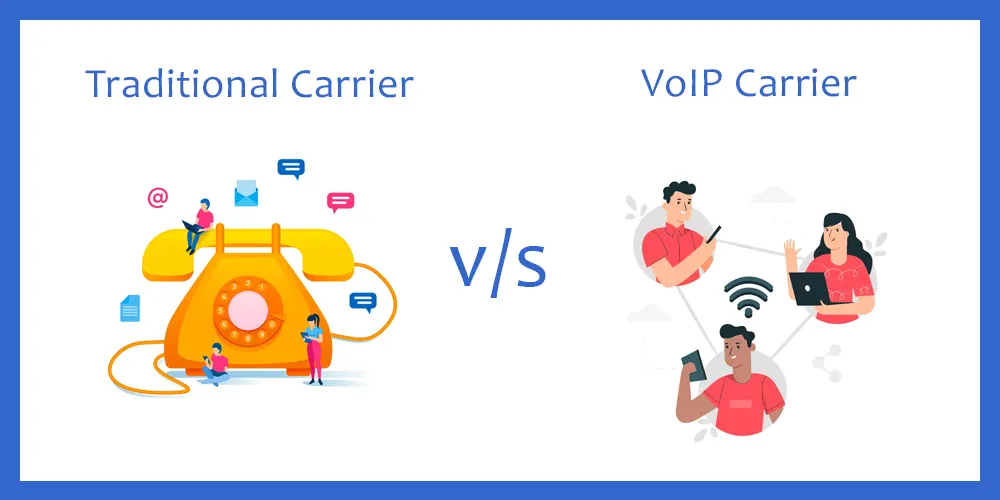
Traditional carriers are limited in their flexibility. They have to install physical lines to connect businesses to their network, which can be time-consuming and expensive.
VoIP carriers are much more flexible, as they can be accessed from anywhere with an internet connection. However, this may also prove to be a limiting factor in some regions.
Difference #4: Mobility
Traditional carriers are not mobile. If you move to a new location, you may have to change your phone number or pay for call forwarding.
With VoIP carriers, you can take your phone number with you, as long as you have an internet connection.
Difference #5: Features
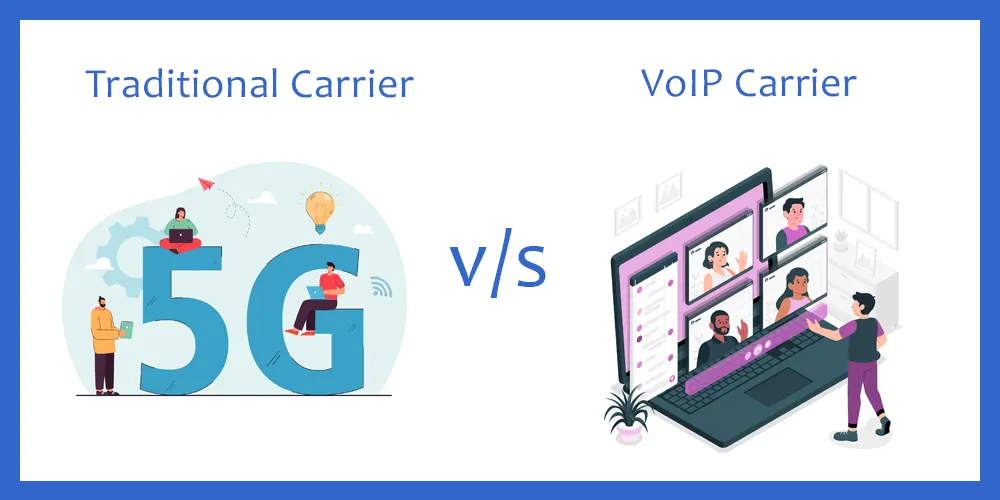
Traditional carriers offer basic features such as call waiting, caller ID, and voicemail. While the roll-out of 5G and LTE have improved things, they’re still playing catch up to VoIP carriers.
VoIP carriers offer advanced features such as video conferencing, instant messaging, and virtual phone numbers and many more.
Difference #6: Reliability
Traditional carriers have been around for over a century and have established a reputation for reliability. Moreover, owning and operating all your communication infrastructure adds in an additional layer of stability and resilience.
VoIP carriers are relatively new and may not have the same reputation for reliability. However, it is safe to say that VoIP carriers are quite capable. You may also conclude that a VoIP carrier is as reliable as the internet providers in your region.
Difference #7: Quality
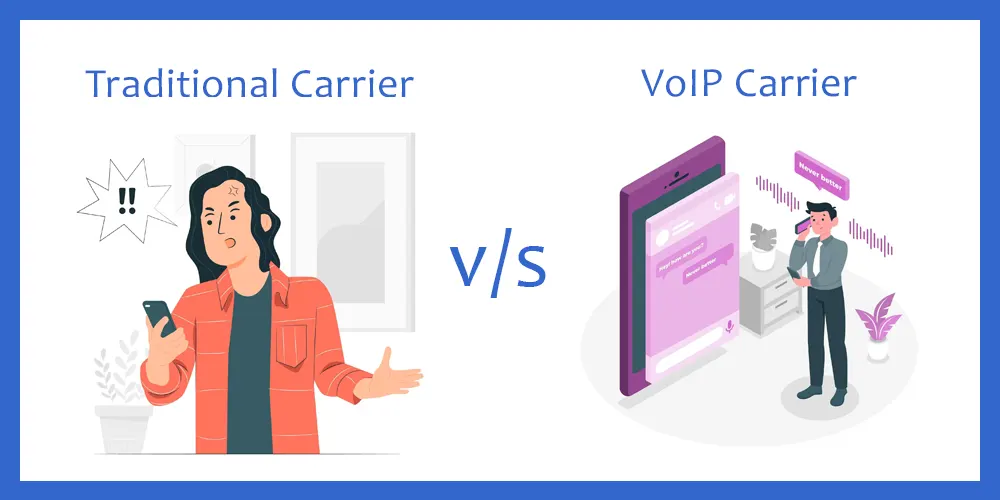
Traditional carriers offer high-quality voice calls, but the quality can vary depending on the distance of the call. The type of signal you’re receiving can also affect your call. 4G LTE and 5G offer good audio however 3G doesn't provide a similar experience.
VoIP carriers offer high-quality voice calls and often have better sound quality than traditional carriers. This is possible due to the higher bandwidth availability via the Internet and the availability of lossless audio codecs.
Difference #8: Security
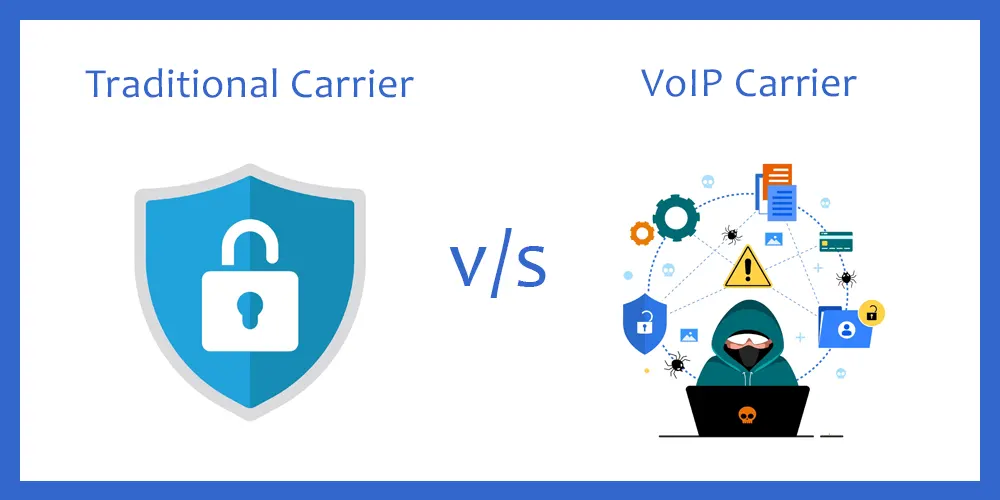
Traditional carriers are more secure than VoIP carriers. Traditional carriers use physical lines that are difficult to tap into. While this does not eliminate the risks entirely, they’re relatively more secure.
VoIP carriers operate via the internet alongside other web traffic. Thus, there are two risks involved here. Your traffic can be identified and targeted easily. Or your traffic may end up caught in a cross-fire during a wide scale network attack.
Difference #9: Integration

Traditional carriers can be integrated with other communication systems, such as fax machines and modems. However, they completely lack the ability to interact with computer or computer programs.
In addition to having the ability to integrate with the systems mentioned above, VoIP carriers can also be integrated with computers and computer softwares such as soft phones and CRMs.
Difference #10: Scalability

Traditional carriers are not easily scalable. Adding new lines or increasing bandwidth can be time-consuming and expensive.
VoIP carriers are much more scalable and can easily be expanded to accommodate new users. However, as mentioned before, the availability of the internet can prove to be a limiting factor for scalability.
I hope now you have clarity regarding the differences between a VoIP and traditional carrier. Let’s double down on this and learn their advantages and disadvantages!
Advantages and Disadvantages of Traditional and VoIP Carriers
Now that we've looked at the differences between traditional carriers and VoIP carriers, let's discuss their advantages and disadvantages.
Advantages of Traditional Carriers:
1. Reliability: Traditional carriers typically have a well-established infrastructure with redundant systems, making them highly reliable. They also have extensive coverage areas, ensuring that your communication needs are met regardless of your location.
2. Audio Quality: Traditional carriers offer high-quality voice and data services that are known for their stability and consistency. They use dedicated circuits for voice and data transmission, which ensures that the connection is always stable.
3. Security: Traditional carriers have extensive security measures in place to ensure that their networks are protected from unauthorized access and hacking attempts. This makes them a safer option for sensitive business communication.
4. Support: Traditional carriers offer dedicated customer support services that are available round the clock. You can rely on their support teams to help you troubleshoot issues and ensure that your communication channels remain functional at all times.
5. Integration: Traditional carriers often provide additional services such as internet connectivity, video conferencing, and other communication tools that can be integrated with their existing infrastructure. This makes it easier for businesses to manage all their communication needs from a single source.
Disadvantages of Traditional Carriers:
1. Associated Cost: Traditional carriers often charge high rates for their services, including long-distance calls and international calling. This can lead to expensive monthly bills for businesses and individuals alike.
2. Limited Features: Traditional carriers typically offer limited features, such as call waiting, caller ID, and voicemail.
More advanced features, such as video conferencing and virtual phone systems, may not be available or may come at an additional cost.
3. Inflexibility: Traditional carriers often require a contract and have limited flexibility in terms of changing plans or services. This can be frustrating for businesses and individuals who want to make changes quickly or as needed.
4. Maintenance: Traditional carriers require physical equipment, such as phone lines and PBX systems, which can not only be costly but complex to maintain and upgrade.
5. Dependence on Location: Traditional carriers require physical infrastructure, such as wires and cables, which limits their coverage area and can create connectivity issues in remote or rural areas.
6. Lack of Mobility: Traditional carriers are often tied to a physical location, making it difficult for businesses and individuals to use their phone systems on the go or from remote locations.
Advantages of VoIP Carriers:
1. Cost Savings: VoIP systems are typically less expensive than traditional phone systems, as they rely on internet connectivity rather than traditional phone lines.
This can result in significant cost savings for businesses, particularly those that make a lot of long-distance or international calls.
2. Flexibility: VoIP systems are highly flexible, allowing businesses to easily add or remove users, as well as to scale up or down as needed. This makes them ideal for businesses with fluctuating staffing needs, as well as those that are growing rapidly.
3. Advanced Features: VoIP systems offer a wide range of advanced features that are not available with traditional phone systems, such as video conferencing, call recording, voicemail-to-email transcription, and more.
4. Mobility: VoIP systems can be used from anywhere with an internet connection, allowing employees to work remotely or while traveling without any disruption to their phone service.
5. Integration: VoIP systems can be easily integrated with other business applications, such as customer relationship management (CRM) systems, email clients, and more. This makes it easier for employees to manage their communications and stay organized.
6. Improved Call Quality: VoIP systems typically offer higher call quality than traditional phone systems, as they use digital rather than analog signals. This can result in clearer calls and fewer dropped connections.
Disadvantages of VoIP Carriers:
1. Dependence on internet connection: As VoIP is a digital technology, it relies on the internet and its quality a lot.
Communication quality and reliability can be affected by the stability and performance of the internet connection. Poor internet connectivity or power outages can lead to disruptions in service.
2. Emergency services: VoIP services are location-independent, meaning they don't rely on a physical address like traditional phone lines. This makes it difficult for emergency services to locate the caller in case of an emergency.
3. Limited power backup: Unlike traditional phone lines, VoIP systems rely on power to function. In the event of a power outage, the VoIP system may not work, unless it has a battery backup.
4. Sound quality issues: The sound quality of a VoIP call can sometimes be affected by factors such as latency, jitter, and packet loss. This can lead to echoes, delays, and dropped calls, which can be frustrating for users.
5. Security concerns: As VoIP calls are transmitted over the internet, they are vulnerable to security threats such as hacking, phishing, and malware attacks.
Without proper security measures in place, sensitive information such as credit card details and personal data can be compromised.
5. Incompatibility with some devices: Some older devices may not be compatible with VoIP systems, requiring businesses to upgrade their equipment to take advantage of VoIP services.
With that, I'm sure there’s no stone left unturned. Let us proceed to the final section in this blog and see what factors you should consider while choosing between the two!
7 Factors You Should Consider While Choosing a Carrier!
Knowing the following factors will allow you to choose a carrier type that is best suited for either your individual or business requirements.
Here are the top 7 factors you should consider!
1. Call Quality

Call quality is an important factor to consider, especially for businesses that rely heavily on communication. Traditional carriers often provide higher call quality, as they use dedicated networks for voice communication.
However, with improvements in VoIP technology, call quality has significantly improved and can often match that of traditional carriers.
2. Cost

Cost is a crucial factor when choosing a carrier, especially for businesses that need to manage their expenses. VoIP carriers often offer lower prices than traditional carriers, as they don't need to maintain physical infrastructure.
However, the cost of equipment and installation may add up, and some VoIP providers may charge additional fees for certain features.
3. Features
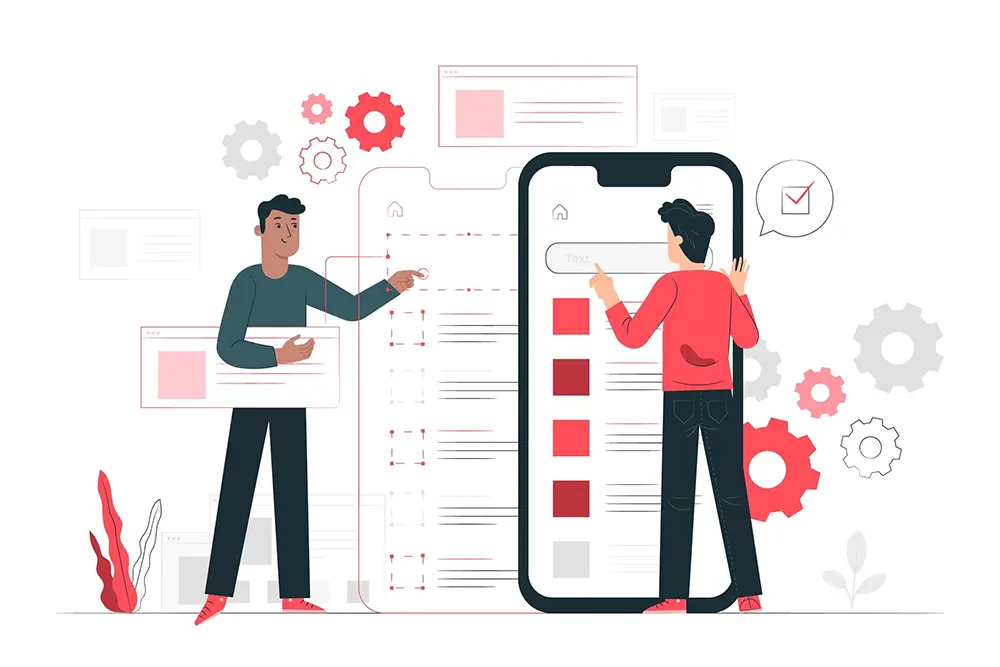
Both traditional and VoIP carriers offer a range of features to enhance communication, such as voicemail, call forwarding, conferencing, and more.
However, the features offered by each carrier may differ, and businesses should carefully evaluate which features are most important for their specific needs.
4. Scalability

Businesses should also consider their future growth and whether their chosen carrier can easily scale with them.
VoIP carriers often offer more flexibility and scalability, as they can easily add new lines and features without needing to install additional infrastructure.
5. Reliability
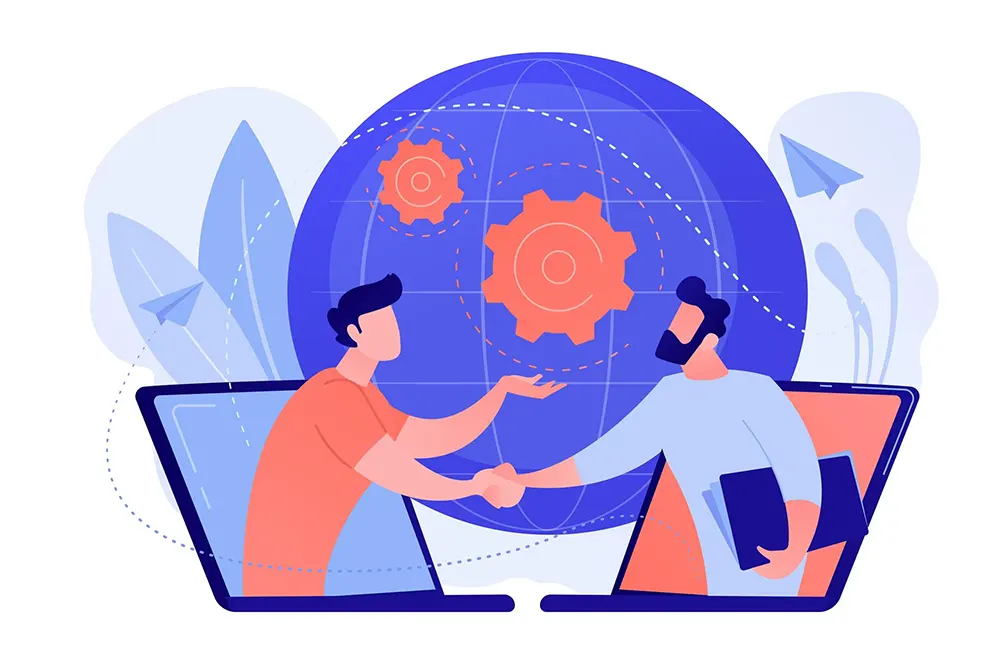
Reliable communication is essential for businesses, and carriers should be evaluated on their uptime and availability. Traditional carriers have a long-standing reputation for reliability, but VoIP carriers have made significant strides in recent years and offer similar uptime guarantees.
6. Security
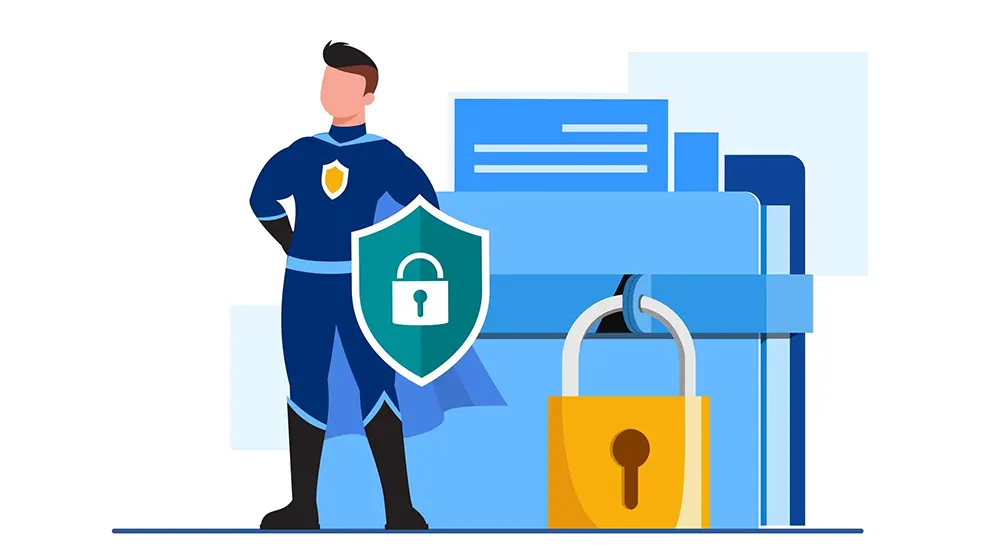
Businesses that handle sensitive information should also consider the security of their chosen carrier. Traditional carriers often provide secure connections, but VoIP carriers may be more vulnerable to hacking and other security threats. It's important to choose a carrier that provides secure encryption and other security features.
7. Customer Support

Finally, businesses should consider the level of customer support offered by their chosen carrier. Both traditional and VoIP carriers should provide reliable and responsive support to address any issues or concerns that arise.
Conclusion
In conclusion, traditional carriers and VoIP carriers each have their advantages and disadvantages. The choice comes down to which one is best suited for a business or individual depending on their specific needs.
Whether you choose a traditional carrier or a VoIP carrier, one thing is for sure, the world of telecommunication is constantly evolving. This makes it important to stay up to date with the latest trends and technologies.
Sign up to our newsletter to stay updated with the latest news in telecommunication!
























































































































